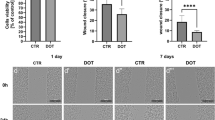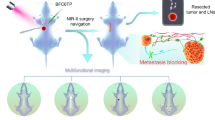Abstract
Objective
Using RGD10–NGR9 dual-targeting superparamagnetic iron oxide nanoparticles to evaluate their potential value in tumor angiogenesis magnetic resonance imaging (MRI) and the biodistribution in vitro and in vivo.
Materials and methods
Dual-targeting RGD10–NGR9 ultrasmall superparamagnetic iron oxide (USPIO) nanoparticles were designed and synthesized in our previous study. In vitro, prussian blue staining and phenanthroline colorimetry were conducted to evaluate binding affinity and adsorption of dual-targeting USPIO nanoparticles to αvβ3-integrin/APN positive cells. In vivo, a xenograft mouse tumor model was used to evaluate the potential of the dual-targeting nanoparticles as an MRI contrast agent. After intravenous injection, the contrast-to-noise ratio (CNR) values of MR images obtained were calculated at predetermined time-points. The iron level was detected to access the biodistribution and plasma half-time.
Results
In vitro, dual-targeting USPIO nanoparticles bound to proliferating human umbilical vein endothelia cells with high specificity. In vivo, contrast MRI of xenograft mice using dual-targeting nanoparticles demonstrated a significant decrease in signal intensity and a greater increase in CNR than standard MRI and facilitated the imaging of tumor angiogenesis in T2*WI. In terms of biodistribution, dual-targeting USPIO nanoparticles increased to 1.83 times in tumor lesions as compared to the control. And the plasma half-time was about 6.2 h.
Conclusion
A novel RGD10–NGR9 dual-targeting USPIO has a great potential value as a contrast agent for the identification of tumor angiogenesis on MRI, according to the high specific affinity in vitro and in vivo.




Similar content being viewed by others
References
Folkman J. Tumor angiogenesis: therapeutic implications. N Engl J Med. 1971;285(21):1182–6. doi:10.1056/NEJM197111182852108.
Ruoslahti E, Bhatia SN, Sailor MJ. Targeting of drugs and nanoparticles to tumors. J Cell Biol. 2010;188(6):759–68. doi:10.1083/jcb.200910104.
Dobrucki LW, de Muinck ED, Lindner JR, Sinusas AJ. Approaches to multimodality imaging of angiogenesis. J Nucl Med. 2010;51(Suppl 1):66S–79S. doi:10.2967/jnumed.109.074963.
Hanahan D, Weinberg RA. Hallmarks of cancer: the next generation. Cell. 2011;144(5):646–74. doi:10.1016/j.cell.2011.02.013.
Laurent S, Bridot JL, Elst LV, Muller RN. Magnetic iron oxide nanoparticles for biomedical applications. Future Med Chem. 2010;2(3):427–49. doi:10.4155/fmc.09.164.
Mahmoudi M, Sant S, Wang B, Laurent S, Sen T. Superparamagnetic iron oxide nanoparticles (SPIONs): development, surface modification and applications in chemotherapy. Adv Drug Deliv Rev. 2011;63(1–2):24–46. doi:10.1016/j.addr.2010.05.006.
Peng XH, Qian X, Mao H, Wang AY, Chen ZG, Nie S, et al. Targeted magnetic iron oxide nanoparticles for tumor imaging and therapy. Int J Nanomed. 2008;3(3):311–21.
Holig P, Bach M, Volkel T, Nahde T, Hoffmann S, Muller R, et al. Novel RGD lipopeptides for the targeting of liposomes to integrin-expressing endothelial and melanoma cells. Protein Eng Des Sel. 2004;17(5):433–41. doi:10.1093/protein/gzh055.
Corti A, Curnis F, Arap W, Pasqualini R. The neovasculature homing motif NGR: more than meets the eye. Blood. 2008;112(7):2628–35. doi:10.1182/blood-2008-04-150862.
Harris TD, Kalogeropoulos S, Nguyen T, Liu S, Bartis J, Ellars C, et al. Design, synthesis, and evaluation of radiolabeled integrin alpha v beta 3 receptor antagonists for tumor imaging and radiotherapy. Cancer Biother Radiopharm. 2003;18(4):627–41. doi:10.1089/108497803322287727.
Bhagwat SV, Petrovic N, Okamoto Y, Shapiro LH. The angiogenic regulator CD13/APN is a transcriptional target of Ras signaling pathways in endothelial morphogenesis. Blood. 2003;101(5):1818–26. doi:10.1182/blood-2002-05-1422.
Curnis F, Sacchi A, Gasparri A, Longhi R, Bachi A, Doglioni C, et al. Isoaspartate-glycine-arginine: a new tumor vasculature-targeting motif. Cancer Res. 2008;68(17):7073–82. doi:10.1158/0008-5472.CAN-08-1272.
Zhang C, Jugold M, Woenne EC, Lammers T, Morgenstern B, Mueller MM, et al. Specific targeting of tumor angiogenesis by RGD-conjugated ultrasmall superparamagnetic iron oxide particles using a clinical 1.5-T magnetic resonance scanner. Cancer Res. 2007;67(4):1555–62. doi:10.1158/0008-5472.CAN-06-1668.
Oostendorp M, Douma K, Hackeng TM, Dirksen A, Post MJ, van Zandvoort MA, et al. Quantitative molecular magnetic resonance imaging of tumor angiogenesis using cNGR-labeled paramagnetic quantum dots. Cancer Res. 2008;68(18):7676–83. doi:10.1158/0008-5472.CAN-08-0689.
Wu QY, Shi JY, Zhang J, Zhang LQ, Zhao YM, Tang L, et al. Preparation of ανβ3 integrin and aminopeptidase N dual-targeting RGD10-NGR9-superparamagnetic iron oxide. Chin J Med Imaging Tech. 2013;29(9):1418–22.
Braunschweig J, Bosch J, Heister K, Kuebeck C, Meckenstock RU. Reevaluation of colorimetric iron determination methods commonly used in geomicrobiology. J Microbiol Methods. 2012;89(1):41–8. doi:10.1016/j.mimet.2012.01.021.
Maupetit J, Derreumaux P, Tuffery P. PEP-FOLD: an online resource for de novo peptide structure prediction. Nucleic Acids Res. 2009;37:W498–503. doi:10.1093/nar/gkp323 (Web Server issue).
Maupetit J, Derreumaux P, Tuffery P. A fast method for large-scale de novo peptide and miniprotein structure prediction. J Comput Chem. 2010;31(4):726–38. doi:10.1002/jcc.21365.
Hsieh W-J, Liang C-J, Chieh J-J, Wang S-H, Lai IR, Chen J-H, et al. In vivo tumor targeting and imaging with anti-vascular endothelial growth factor antibody-conjugated dextran-coated iron oxide nanoparticles. Int J Nanomed. 2012;7:2833–42. doi:10.2147/IJN.S32154.
Dijkgraaf I, Beer AJ, Wester HJ. Application of RGD-containing peptides as imaging probes for alphavbeta3 expression. Front Biosci (Landmark Ed). 2009;14:887–99.
Garanger E, Boturyn D, Dumy P. Tumor targeting with RGD peptide ligands-design of new molecular conjugates for imaging and therapy of cancers. Anticancer Agents Med Chem. 2007;7(5):552–8.
Arap W, Pasqualini R, Ruoslahti E. Cancer treatment by targeted drug delivery to tumor vasculature in a mouse model. Science. 1998;279(5349):377–80.
Jun YW, Huh YM, Choi JS, Lee JH, Song HT, Kim S, et al. Nanoscale size effect of magnetic nanocrystals and their utilization for cancer diagnosis via magnetic resonance imaging. J Am Chem Soc. 2005;127(16):5732–3. doi:10.1021/ja0422155.
Taupitz M, Schmitz S, Hamm B. Superparamagnetic iron oxide particles: current state and future development. Rofo. 2003;175(6):752–65. doi:10.1055/s-2003-39935.
Meng W, Parker TL, Kallinteri P, Walker DA, Higgins S, Hutcheon GA, et al. Uptake and metabolism of novel biodegradable poly (glycerol-adipate) nanoparticles in DAOY monolayer. J Control Release. 2006;116(3):314–21. doi:10.1016/j.jconrel.2006.09.014.
Jensen KD, Nori A, Tijerina M, Kopeckova P, Kopecek J. Cytoplasmic delivery and nuclear targeting of synthetic macromolecules. J Control Release. 2003;87(1–3):89–105.
Trivedi RA, Jean-Marie U, Graves MJ, Cross JJ, Horsley J, Goddard MJ, et al. In vivo detection of macrophages in human carotid atheroma: temporal dependence of ultrasmall superparamagnetic particles of iron oxide-enhanced MRI. Stroke. 2004;35(7):1631–5. doi:10.1161/01.STR.0000131268.50418.b7.
Acknowledgements
This work was supported by the Science and Technology Commission of Shanghai Municipality (No. 14411966400, 15ZR1434500), National Natural Science Foundation of China (No. 81572269).
Author information
Authors and Affiliations
Corresponding authors
Ethics declarations
Conflict of interest
The authors indicate no potential conflicts of interest.
Ethical approval
The animal study was conducted in accordance with the Institutional Animal Care and Use Committee (IACUC) guidelines and was under approval of Tongji University Animal Center.
Rights and permissions
About this article
Cite this article
Wu, T., Ding, X., Su, B. et al. Magnetic resonance imaging of tumor angiogenesis using dual-targeting RGD10–NGR9 ultrasmall superparamagnetic iron oxide nanoparticles. Clin Transl Oncol 20, 599–606 (2018). https://doi.org/10.1007/s12094-017-1753-8
Received:
Accepted:
Published:
Issue Date:
DOI: https://doi.org/10.1007/s12094-017-1753-8




